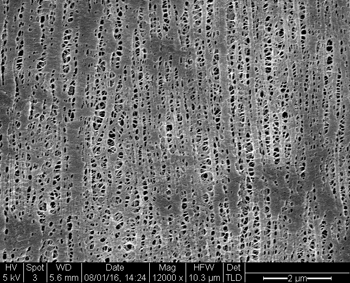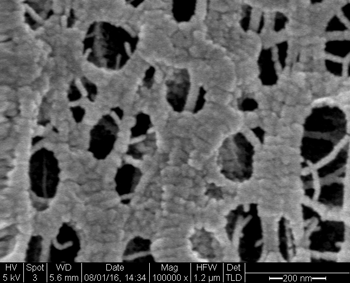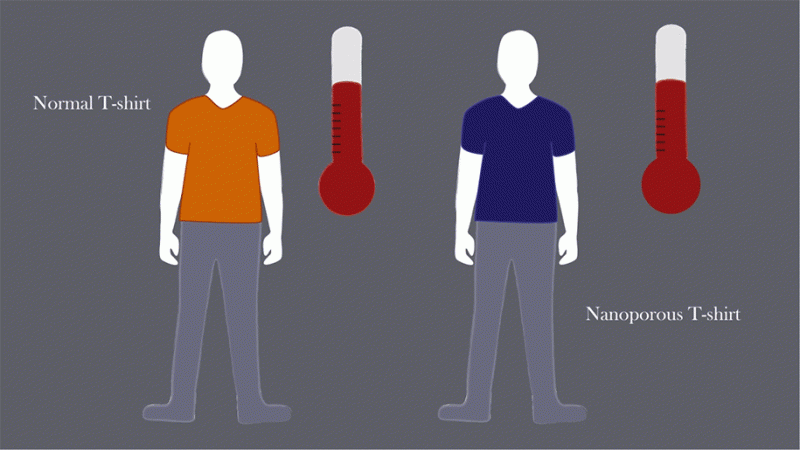Hot, hot, hot? New fabric could help you stay cool
Material made of bubble-filled plastic lets body heat escape

What you wear affects how hot you get. Scientists are now developing new fabrics that could help people stay cooler while fully clothed.
DeanDrobot/istockphoto
By Sid Perkins
When it’s cold outside, it’s pretty easy to put on more clothes to stay warm. But when it’s hot, there are only so many layers of clothing you can peel off. In most places, after all, it’s not polite to run around naked! Now, researchers have developed a new type of fabric that holds in very little body heat. That could keep the wearer cooler than is possible with other fabrics.
Clothes help warm the body. And they do it several ways. The first is by preventing a process known as convection. Here, fabric traps a layer of air next to the skin. Once warmed, this air cuts the flow of heat out of the body. If the clothes weren’t there, any air the body warmed would drift away, via convection. Cooler air would move in to take its place. That new air would now pick up more body heat and carry it away, too.
A second way that clothes keep us warm is by blocking the release of body heat through a process known as radiation. Like light, heat is a form of electromagnetic radiation. In winter, blocking the loss of body heat — and thus staying warm — is a good thing. But in summer, when overheating can be a problem, it would be nice to let heat leave the body, says Yi Cui. He’s a materials scientist at Stanford University in Palo Alto, Calif.
So Cui’s team came up with a fabric that’s transparent to body heat. It lets that energy just radiate away.
The researchers described their new fabric September 2 in Science.

Making a fabric largely invisible to body heat
Because its energy is lower than that of visible light, heat is known as infrared radiation. (The prefix infra, from Latin, means “below.”) This radiation also has longer wavelengths than visible light. (Wavelength is the distance from one peak of a wave to the next.) And those differences in wavelength were key to designing a fabric that would block visible light but not stand in the way of body heat, explains Cui.
When radiation (such as heat or light) reaches an object, it can bounce off or travel around it. Which happens will depend largely on two things: the size of the object and the wavelength of the radiation. If a wave is the same size as an object or smaller, it usually reflects off of the object. That’s why the sky is blue. Wavelengths of blue light are about the same size as gas molecules in the air. So, they hit the molecules and scatter in all directions. Other colors, including red light, have longer wavelengths. They pass right around the gas molecules.
When designing their new fabric, Cui and his team started with a common plastic. It’s known as polyethylene (PAHL-ee-ETH-ul-een). People turn millions of tons of it into bottles and packaging each year. A thin flexible film of it can also be found in batteries, notes Cui. (The type used in batteries is very similar to what’s used in grocery bags.) This plastic is cheap, costing only about $2 per square meter (about 10.5 square feet).

But the new material’s great advantage is its structure. Unlike the version of the plastic used in bottles and many bags, the new version includes tiny fused bubbles, or nanopores. Those bubbles — each around a billionth of a meter in diameter — are interconnected and let fluids (like air) flow from one side to another. Overall, when seen up close, the material looks like a very thin, very tiny version of a kitchen sponge.
Cui and his team modified the material to make its bubbles a particular size. If most are between 50 and 1,000 nanometers (or up to 39 millionths of an inch) across, they’ll scatter and block visible light. (The wavelengths of visible light vary between about 400 nanometers — red, and 700 nanometers — blue.) But infrared wavelengths are larger than the material’s nanopores. So heat will radiate right around the tiny bubbles.
For infrared wavelengths above 2,000 nanometers, more than 90 percent of this heat will pass through.
How cool?
The team came up with a way to test how well heat (that infrared radiation) will pass through the new fabric. When wearing a cotton shirt, a man’s skin temperature would climb about 3.5° Celsius (6.3° Fahrenheit) higher than if he wore no shirt at all. But in a shirt made from the team’s new fabric, his skin would feel only 0.8 °C (about 1.4 °F) warmer than if he went shirtless. (Of course, they never made such a shirt. They didn’t make enough of the new fabric.)
That’s a big temperature difference, says Cui. And it would likely make a big difference in household energy bills too. Someone who feels cool doesn’t need to set the thermostat for the air conditioning too low. And that would save money. For every 1 °C (1.8 °F) warmer the air-conditioning’s thermostat is set, residents will use about 10 percent less household energy, studies have shown.
And that’s a big deal. “Air conditioning is one of the biggest energy costs in the nation,” says Ping Liu. He’s a chemist at the University of California, San Diego. Reducing those bills would save people lots of money. It also would reduce the amount of electricity that power plants would need to provide. Many of those power plants generate electricity by burning coal or other fossil fuels. That burning emits carbon dioxide gas, a planet-warming greenhouse gas.

Overall, Cui notes, heating and cooling buildings accounts for about one-eighth of all energy used in the United States.
His team’s new fabric, for now, has only been tested in the lab. It hasn’t been made in large quantities. But it isn’t the only type of fabric that could let lots of body heat escape, notes Svetlana Boriskina. She’s a physicist at the Massachusetts Institute of Technology in Cambridge.
Last year, her team came up a different approach. This group, too, would use polyethylene. But it would start with bubble-free fibers of the plastic that were 1 micrometer across (about one-seventeenth the width of the finest human hair). Then, they would wind these fibers together to make strands of yarn about 30 micrometers across. Their fabric would be woven from this yarn.
Boriskina and her teammates described their fabric last year in ACS Photonics. They haven’t made any of this cool fabric yet. But their computer analyses suggest such a fabric would be even more transparent to heat than the one Cui’s group has designed. A mere 3 percent of the body heat would be retained by the material, her team estimates. So wearing it might keep people even somewhat cooler than the Stanford fabric.
Polyethylene is normally clear, says Boriskina. But it’s possible to add pigments or dyes to the material to give it color. Because those colors are inside the material, it would make them less likely to rub off and fade, she notes. But researchers would need to be very careful, she adds, to select pigments that didn’t block infrared radiation.
This is one in a series presenting news on technology and innovation, made possible with generous support from the Lemelson Foundation.







